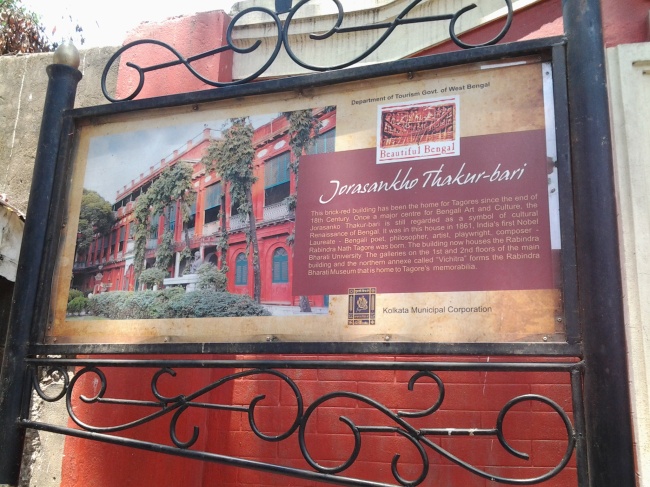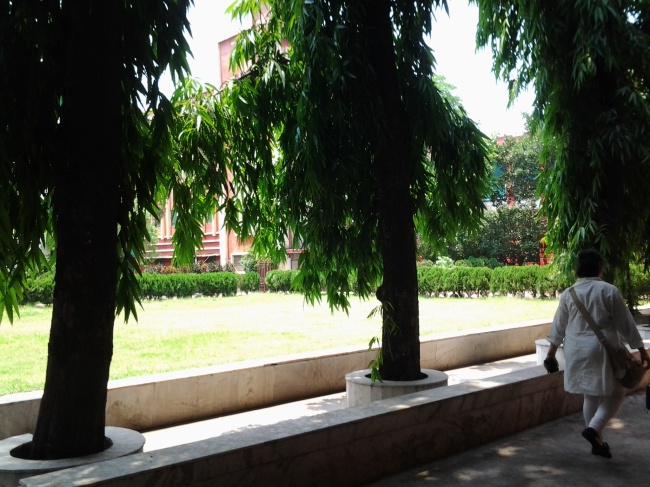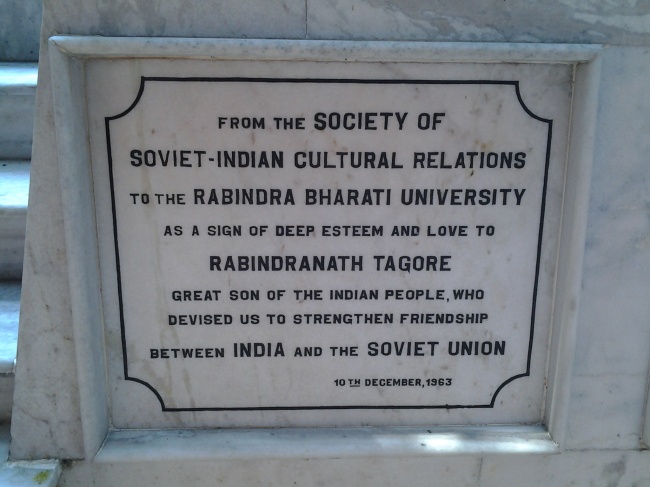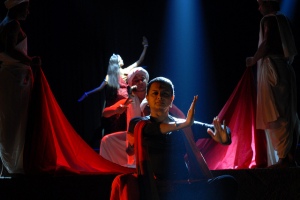‘Jorasanko’ by Aruna Chakravarti opened the doors of a new, hitherto lesser known world to me. The world of Bengal Renaissance. Erstwhile Kolkata (then called Calcutta). The period when reformers like Raja Ram Mohan Roy and Ishwarchandra Vidyasagar contributed in a large way to the gradually changing India.
Bengal Renaissance also gave us the poet Rabindranath Tagore. The Bard of Bengal was born in Jorasanko, Kolkata (I will refer to it thus as this is how we Bengalis have always known it) in a palatial house built by his grandfather, Prince Dwarkanath Tagore. And it was this house that I finally had the opportunity to visit this time.
Nestled in a narrow bylane in Jorasanko (North Kolkata), the huge red mansion also houses the Rabindra Bharati University. The sun’s heat beating down, the four of us (my mother, aunt, brother and myself) made our way to arguably the most famous address in West Bengal.
On entering, we were greeted by the sight of a sprawling lawn. Freshly mowed grass and green trees were a refreshing sight. The black stone bust of the poet, who’s the only person to have penned the national anthems of two countries (India and Bangladesh), stood at the head of the lawn, as if in a silent welcome into his abode. A bust of his father, Debendranath Tagore, stood at a distance from the one of his famous son.
Before entering the museum, we entered a huge courtyard which acted as a little amphitheatre as it had an elevated stage where, we were told, that the talented members of the Tagore family staged their plays and musicals. A friendly man, a worker at the Thakurbari, I presumed, also told us that the palanquins carrying the women of the household were brought right into this courtyard, completely covered, so as to protect the women from the gaze of strangers. It was almost paradoxical that a family that was so progressive in terms of women education still followed the ‘purdah’ system for the ladies!
We later made our way to the entrance of the museum. I was slightly dishearted when, after paying the entrance fee of Rs 10 each and Rs 5 for my brother (student discount), I was told that we had to lock our bags and phones away in the designated lockers kept for this very purpose. There went my chance to click some priceless photos of the interiors of the house! Keeping a little bubble of hope alive in my heart, I asked the person at the ticket counter whether they sold postcards of the interiors. But, alas! That little bubble was punctured as well! Oh well, I have to keep the images stored in my brain’s memory bank then, I decided and entered.
If you, my dear readers, are thinking that Rabindranath Tagore was the only famous member of the Tagore family, well….sorry to say, but you are grossly mistaken! No doubt that he was the shining jewel in the family but his sister, Swarnakumari, who brought in the era of women authors, his brother, Jyotirindranath, a man of many talents (apparently, the only known portrait of the famous Baul, Lalan Fakir, was sketched by him), his sister-in-law Jnanadanandini, who was the first Bengali woman to undertake a journey by sea to England without her husband and also gave us a new, novel way of wearing a saree (the way we wear it now!), were among the many illustrious members of this family.
The museum is replete with articles that were owned by the family. Medals won by Rabindranath, Abanindranath etc, letters written by Rabindranath to his wife, Mrinalini, from England, a sari worn by her, paintings by the artistically inclined members of the family, rare photographs of the Bard and his family members, including that of his muse, Kadambari, as well as a rare photograph of his mother, Sarada. I suspect, Jnanadanandini, who was easily the most progressive member of the family was the one who convinced her mother-in-law to pose for this photo!
Weaving our way in and out of the rooms, we came across the room in which the poet was born, his study and also the room where he breathed his last. We also got an opportunity to see the little kitchen used by Mrinalini. The cherry on the cake was the poet’s car which is being maintained by Howrah Motors.
A visit to Jorasanko Thakurbari was truly an enriching experience for a history-lover like me. Even though the tiny souvenir shop did not stock anything worthwhile except a few books, the memories of the 90 minutes that I spent here as well as some photographs that I, along with my aunt, clicked, are keepsakes enough to last me a lifetime!






